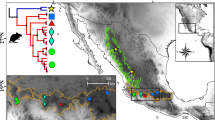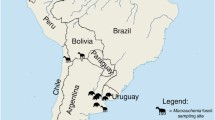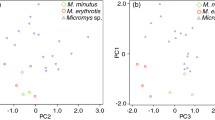Abstract
In this study, we address the question of phylogenetic relationships in the Geomyidae, focusing primarily on intergeneric relationships within the tribe Geomyini. Our study makes use of DNA sequences from two mitochondrial and two nuclear genes, and we use model-based methods of phylogenetic analysis to infer relationships and determine the level of support for each proposed relationship. Relationships among geomyine pocket gopher genera remain only partially resolved despite a number of earlier attempts to reconstruct their phylogenetic history and despite the newly generated sequence data analyzed in this study. This lack of resolution does not appear to result from insufficient or inappropriate DNA data, nor is it caused by inadequate sampling of taxa. Rather, molecular data and fossil data together lead to the conclusion that diversification within the Geomyini likely occurred during a geologically brief period in the Blancan. Rapid climate change during the Blancan, the origin of patchily distributed grasslands, and the evolution of hypsodonty may have triggered the rapid diversification that eventually produced the five extant genera of the Geomyini.
Similar content being viewed by others
LITERATURE CITED
Allard, M. W., and Honeycutt, R. L. (1992). Nucleotide sequence variation in the mitochondrial 12S rRNA gene and the phylogeny of African mole-rats (Rodentia: Bathyerigidae). Mol. Biol. Evol. 9:27–40.
American Society of Mammalogists Index Committee (2001). Ten-year index to Journal of Mammalogy, volumes 71–80, inclusive: 1990–1999. J. Mammal. 82:supplement.
Barker, F. K., and Lutzoni, F. M. (2002). The utility of the incongruence length difference test. Syst. Biol. 51: 625–637.
Cerling, T. E., Harris, J. M., MacFadden, B. J., Leakey, M. G., Quade, J., Eisenmann, V., and Ehleringer, J. R. (1997). Global vegetation change through the Miocene/Pliocene boundary. Nature 389:153–158.
Cummings, M. P., Handley, S. A., Myers, D. S., Reed, D. L., Rokas, A., and Winka, K. (2003). Comparing bootstrap and posterior probability values in the four-taxon case. Syst. Biol. 52:477–487.
Demastes, J. W., Butt, A. L., Hafner, M. S., and Light, J. E. (2003). Systematics of a rare species of pocket gopher, Pappogeomys alcorni. J. Mammal. 84:753–761.
Demastes, J. W., Hafner, M. S., and Hafner, D. J. (1996). Phylogeographic variation in two Central American pocket gophers (Orthogeomys). J. Mammal. 77:917–927.
Demastes, J. W., Spradling, T. A., Hafner, M. S., Hafner, D. J., and Reed, D. L. (2002). Systematics and phylogeography of pocket gophers in the genera Cratogeomys and Pappogeomys. Mol. Phylogenet. Evol. 22: 144–154.
DeWalt, T. S., Sudman, P. D., Hafner, M. S., and Davis, S. K. (1993). Phylogenetic relationships of pocket gophers (Cratogeomys and Pappogeomys) based on mitochondrial DNA cytochrome b sequences. Mol. Phylogenet. Evol. 2:193–204.
Hafner, M. S. (1982). A biochemical investigation of geomyoid systematics (Mammalia: Rodentia). Z. Zool. Syst. Evol.-Forsch. 20:118–130.
Hafner, M. S. (1991). Evolutionary genetics and zoogeography of Middle American pocket gophers, genus Orthogeomys. J. Mammal. 72:1–10.
Hafner, M. S., and Barkley, L. J. (1984). Genetics and natural history of a relictual pocket gopher, Zygogeomys (Rodentia: Geomyidae). J. Mammal. 65:474–479.
Hafner, M. S., Spradling, T. A., Light, J. E., Hafner, D. J., and Demboski, J. R. (in press). Systematic revision of pocket gophers of the Cratogeomys gymnurus species group. J. Mammal.
Hafner, M. S., Sudman, P. D., Villablanca, F. X., Spradling, T. A., Demastes, J. W., and Nadler, S. A. (1994). Disparate rates of molecular evolution in cospeciating hosts and parasites. Science 265:1087–1090.
Hall, B. G. (2001). Phylogenetic Trees Made Easy, Sinauer Associates, Sunderland, MA.
Hall, E. R. (1981). The Mammals of North America, 2nd edn., Blackburn Press, Caldwell, NJ.
Hasegawa, M., Kishino, K., and Yano, T. (1985). Dating the human–ape splitting by a molecular clock of mitochondrial DNA. J. Mol. Evol. 22:160–174.
Hewitt, G. M. (2001). Speciation, hybrid zones and phylogeography—or seeing genes in space and time. Mol. Ecol. 10:537–549.
Honeycutt, R. L., and Williams, S. L. (1982). Genic differentiation in pocket gophers of the genus Pappogeomys, with comments on intergeneric relationships in the subfamily Geomyinae. J. Mammal. 63:208–217.
Huelsenbeck, J. P., Bull, J. J., and Cunningham, C. W. (1996). Combining data in phylogenetic analysis. Trends Ecol. Evol. 11:152–158.
Huelsenbeck, J. P., and Ronquist, F. (2001). MRBAYES: Bayesian inference of phylogenetic trees. Bioinformatics 17: 754–755.
Johnson, K. P. (2001). Taxon sampling and the phylogenetic position of Passeriformes: Evidence from 916 avian cytochrome b sequences. Syst. Biol. 50:128–136.
Jukes, T. H., and Cantor, C. R. (1969). Evolution of protein molecules. In: Mammalian Protein Metabolism, H. M. Munro, ed., pp. 21–132, Academic Press, New York.
Korth, W. W. (1994). The Tertiary Record of Rodents in North America, Plenum, New York.
Kurtén, B., and Anderson, E. (1980). Pleistocene Mammals of North America, Columbia University Press, New York.
Lanyon, S. M. (1988). The stochastic mode of molecular evolution: What consequences for systematic investiga-tion? Auk 105:565–573.
Li, W.-H., and Graur, D. (1991). Fundamentals of Molecular Evolution, Sinauer Associates, Sunderland, MA.
Lindsay, E., Mou, Y., Downs, W., Pederson, J., Kelly, T. S., Henry, C., and Trexler, J. (2002). Recognition of the Hemphillian/Blancan boundary in Nevada. J. Vertebr. Paleontol. 22:429–442.
Martin, R. A., Goodwin, H. T., and Farlow, J. O. (2002). Late Neogene (Late Hemphillian) rodents from the Pipe Creek Sinkhole, Grant County, Indiana. J. Vertebr. Paleontol. 22:137–151.
Merriam, C. H. (1895). Monographic revision of the pocket gophers (family Geomyidae). N. Am. Fauna 8:1–220.
Mindell, D. P., and Honeycutt, R. L. (1990). Ribosomal RNA in vertebrates: Evolution and phylogenetic applica-tions. Annu. Rev. Ecol. Syst. 21:541–566.
Omilian, A. R., and Taylor, D. J. (2001). Rate acceleration and long-branch attraction in a conserved gene of cryptic daphniid (Crustacea) species. Mol. Biol. Evol. 18:2201–2212.
Phillips, M. J., Lin, Y.-H., Harrison, G. L., and Penny, D. (2001). Mitochondrial genomes of a bandicoot and a brushtail possum confirm the mophyly of australidelphian marsupials. Proc. R. Soc. Lond. B 268:1533–1538.
Posada, D., and Crandall, K. A. (1998). Modeltest: Testing the model of DNA substitution. Bioinformatics 14: 817–818.
Prychitko, T. M., and Moore, W. S. (1997). The utility of DNA sequences of an intron from the â-fibrinogen gene in phylogenetic analysis of woodpeckers (Aves: Picidae). Mol. Phylogenet. Evol. 8:193–204.
Rodríguez, F., Oliver, J. F., Marín, A., and Medina, J. R. (1990). The general stochastic model of nucleotide substitution. J. Theor. Biol. 142:485–501.
Russell, R. J. (1968a). Evolution and classification of the pocket gophers of the subfamily Geomyinae. Univ. Kansas Pubs. Mus. Nat. Hist. 16:473–579.
Russell, R. J. (1968b). Revision of pocket gophers of the genus Pappogeomys. Univ. Kansas Pubs. Mus. Nat. Hist. 16: 581–776.
Sanderson, M. J. (1997). Anonparametric approach to estimating divergence times in the absence of rate constancy. Mol. Biol. Evol. 14:1218–1231.
Savage, D. E., and Russell, D. E.. (1983). Mammalian Paleofaunas of the World, Addison-Wesley, Reading, MA.
Seddon, J. M., Santucci, F., Reeve, N. J., and Hewitt, G. M. (2001). DNA footprints of European hedgehogs, Erinaceus europaeus and E. concolor: Pleistocene refugia, postglacial expansion and colonization routes. Mol. Ecol. 10:2187–2198.
Simpson, G. G. (1945). The principles of classification and a classification of mammals. Bull. Am. Mus. Nat. Hist. 85: i–xvi, 1–350.
Smith, M. F. (1998). Phylogenetic relationships and geographic structure in pocket gophers in the genus Thomomys. Mol. Phylogenet. Evol. 9:1–14.
Spradling, T. A., Hafner, M. S., and Demastes, J. W. (2001). Differences in rate of cytochrome-b evolution among species of rodents. J. Mammal. 82:65–80.
Steppan, S. J., Storz, B. L., and Hoffmann, R. S. (2004). Nuclear DNA phylogeny of the squirrels (Mammalia: Rodentia) and the evolution of arboreality from c-myc and Rag1. Mol. Phylogenet. Evol. 30:703–719.
Sudman, P. D., and Hafner, M. S. (1992). Phylogenetic relationships among Middle American pocket gophers (Genus Orthogeomys) based on mitochondrial DNA sequences. Mol. Phylogenet. Evol. 1:17–25.
Sullivan, J., and Swofford, D. (1997). Are guinea pigs rodents? The importance of adequate models in molecular phylogenetics. J. Mamm. Evol. 4:77–86.
Swofford, D. L. (2002). PAUP*. Phylogenetic Analysis Using Parsimony (*and Other Methods), Version 4.0b10, Sinauer Associates, Sunderland, MA.
Takezaki, N., Rzhetsky, A., and Nei, M. (1995). Phylogenetic test of the molecular clock and linearized trees. Mol. Biol. Evol. 12:823–833.
Tamura, K., and Nei, M. (1993). Estimation of the number of nucleotide substitutions in the control region of mitochondrial DNA in humans and chimpanzees. Mol. Biol. Evol. 10:512–526.
Thaeler, C. S., Jr. (1980). Chromosome numbers and systematic relations in the genus Thomomys (Rodentia: Geomyidae). J. Mammal. 61:414–422.
Thompson, J. D., Gibson, T. J., Plewniak, F., Jeanmougin, F., and Higgins, D. G. (1997). The ClustalX windows interface: Flexible strategies for multiple sequence alignment aided by quality analysis tools. Nucleic Acids Res. 24:4876–4882.
Tomida, Y. (1987). Small Mammal Fossils and Correlation of Continental Deposits, Safford and Duncan Basins, Arizona, USA, National Science Museum, Tokyo.
Wahlert, J. H. (1985). Skull morphology and relationships of geomyoid rodents. Am. Mus. Novit. 2812:1–20.
Webb, S. D. (1977). A history of savanna vertebrates in the new world. Part I: North America. Annu. Rev. Ecol. Syst. 8:355–380.
Webb, S. D., and Opdyke, N. D. (1995). Global climatic influence on Cenozoic Land Mammal Faunas. In: Studiesin Geophysics: Effects of Past Global Change on Life, National Research Council, pp. 184–208, National Academy Press, Washington, DC.
Wood, A. E. (1955). A revised classification of the rodents. J. Mammal. 36:165–187.
Author information
Authors and Affiliations
Rights and permissions
About this article
Cite this article
Spradling, T.A., Brant, S.V., Hafner, M.S. et al. DNA Data Support a Rapid Radiation of Pocket Gopher Genera (Rodentia: Geomyidae). Journal of Mammalian Evolution 11, 105–125 (2004). https://doi.org/10.1023/B:JOMM.0000041191.21293.98
Issue Date:
DOI: https://doi.org/10.1023/B:JOMM.0000041191.21293.98




